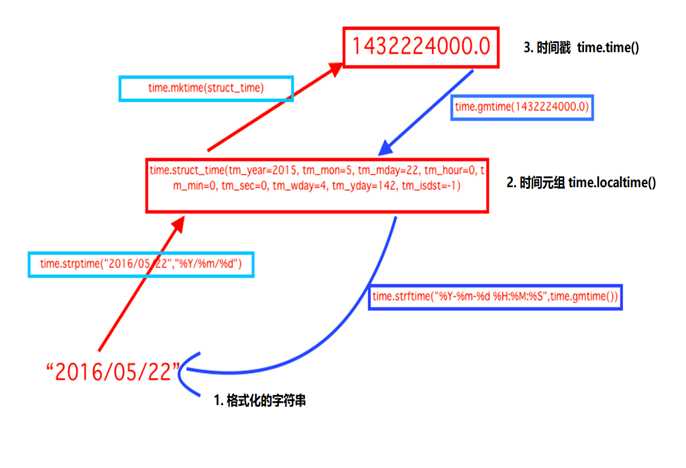标签:source 英文 .com 模块 font pytho struct code mon
1、 time()模块中的重要函数
|
函数 |
描述 |
|
asctime([tuple]) |
将时间元组转换为字符串 |
|
localtime([secs]) |
将秒数转换为日期元组(转换成本国时区而不是utc时区) |
|
mktime(tuple) |
将时间元组转换为本地时间 |
|
sleep(secs) |
休眠(不做任何事情)secs秒 |
|
strptime(string[, format]) |
将字符串解析为时间元组 |
|
time() |
获取当前时间戳 |
time.gmtime() |
将时间转换成utc格式的元组格式 |
2、time()模块时间格式转换

3、time()模块时间转换
1. 时间戳 1970年1月1日之后的秒, 即:time.time()
2. 格式化的字符串 2014-11-11 11:11, 即:time.strftime(‘%Y-%m-%d‘)
3. 结构化时间 元组包含了:年、日、星期等... time.struct_time 即:time.localtime()

import time print(time.time()) # 时间戳:1511166937.2178104 print(time.strftime(‘%Y-%m-%d‘)) # 格式化的字符串: 2017-11-20 print(time.localtime()) # 结构化时间(元组): (tm_year=2017, tm_mon=11...) print(time.gmtime()) # 将时间转换成utc格式的元组格式: (tm_year=2017, tm_mon=11...) #1. 将结构化时间转换成时间戳: 1511167004.0 print(time.mktime(time.localtime())) #2. 将格字符串时间转换成结构化时间 元组: (tm_year=2017, tm_mon=11...) print(time.strptime(‘2014-11-11‘, ‘%Y-%m-%d‘)) #3. 结构化时间(元组) 转换成 字符串时间 :2017-11-20 print(time.strftime(‘%Y-%m-%d‘, time.localtime())) # 默认当前时间 #4. 将结构化时间(元组) 转换成英文字符串时间 : Mon Nov 20 16:51:28 2017 print(time.asctime(time.localtime())) #5. 将时间戳转成 英文字符串时间 : Mon Nov 20 16:51:28 2017 print(time.ctime(time.time()))
4、ctime和asctime区别
1)ctime传入的是以秒计时的时间戳转换成格式化时间
2)asctime传入的是时间元组转换成格式化时间

import time t1 = time.time() print(t1) #1483495728.4734166 print(time.ctime(t1)) #Wed Jan 4 10:08:48 2017 t2 = time.localtime() print(t2) #time.struct_time(tm_year=2017, tm_mon=1, tm_mday=4, tm_hour=10, print(time.asctime(t2)) #Wed Jan 4 10:08:48 2017
5、datetime

import datetime #1、datetime.datetime获取当前时间 print(datetime.datetime.now()) #2、获取三天后的时间 print(datetime.datetime.now()+datetime.timedelta(+3)) #3、获取三天前的时间 print(datetime.datetime.now()+datetime.timedelta(-3)) #4、获取三个小时后的时间 print(datetime.datetime.now()+datetime.timedelta(hours=3)) #5、获取三分钟以前的时间 print(datetime.datetime.now()+datetime.timedelta(minutes = -3)) import datetime print(datetime.datetime.now()) #2017-08-18 11:25:52.618873 print(datetime.datetime.now().date()) #2017-08-18 print(datetime.datetime.now().strftime("%Y-%m-%d %H-%M-%S")) #2017-08-18 11-25-52
1、random()模块常用函数
random模块中一些重要函数
|
函数 |
描述 |
|
random() |
返回0<n<=1 |
|
getrandbits(n) |
以长整形形式返回n个随机位 |
|
uniform(a, b) |
返回随机实数n,其中a<=n<=b |
|
randrange([start], stop, [step]) |
返回range(start,stop,step)中的随机数 |
|
choice(seq) |
从序列seq中返回随意元素 |
|
shuffle(seq[, random]) |
原地指定序列seq(将有序列表变成无序的:洗牌) |
|
sample(sea, n) |
从序列seq中选择n个随机且独立的元素 |

import random #⒈ 随机整数: print(random.randint(0,99)) # 随机选取0-99之间的整数 print(random.randrange(0, 101, 2)) # 随机选取0-101之间的偶数 #⒉ 随机浮点数: print(random.random()) # 0.972654134347 print(random.uniform(1, 10)) # 4.14709813772 #⒊ 随机字符: print(random.choice(‘abcdefg‘)) # c print(random.sample(‘abcdefghij‘,3)) # [‘j‘, ‘f‘, ‘c‘]
2、使用random实现四位验证码

import random checkcode = ‘‘ for i in range(4): current = random.randrange(0,4) if current == i: tmp = chr(random.randint(65,90)) #65,90表示所有大写字母 else: tmp = random.randint(0,9) checkcode += str(tmp) print(checkcode) #运行结果: 851K

import random import string str_source = string.ascii_letters + string.digits str_list = random.sample(str_source,7) #[‘i‘, ‘Q‘, ‘U‘, ‘u‘, ‘A‘, ‘0‘, ‘9‘] print(str_list) str_final = ‘‘.join(str_list) #iQUuA09 print(str_final) # 运行结果: jkFU2Ed
>>> string.digits ‘0123456789‘ >>> string.ascii_lowercase ‘abcdefghijklmnopqrstuvwxyz‘
标签:source 英文 .com 模块 font pytho struct code mon
原文地址:http://www.cnblogs.com/xiaonq/p/7866925.html